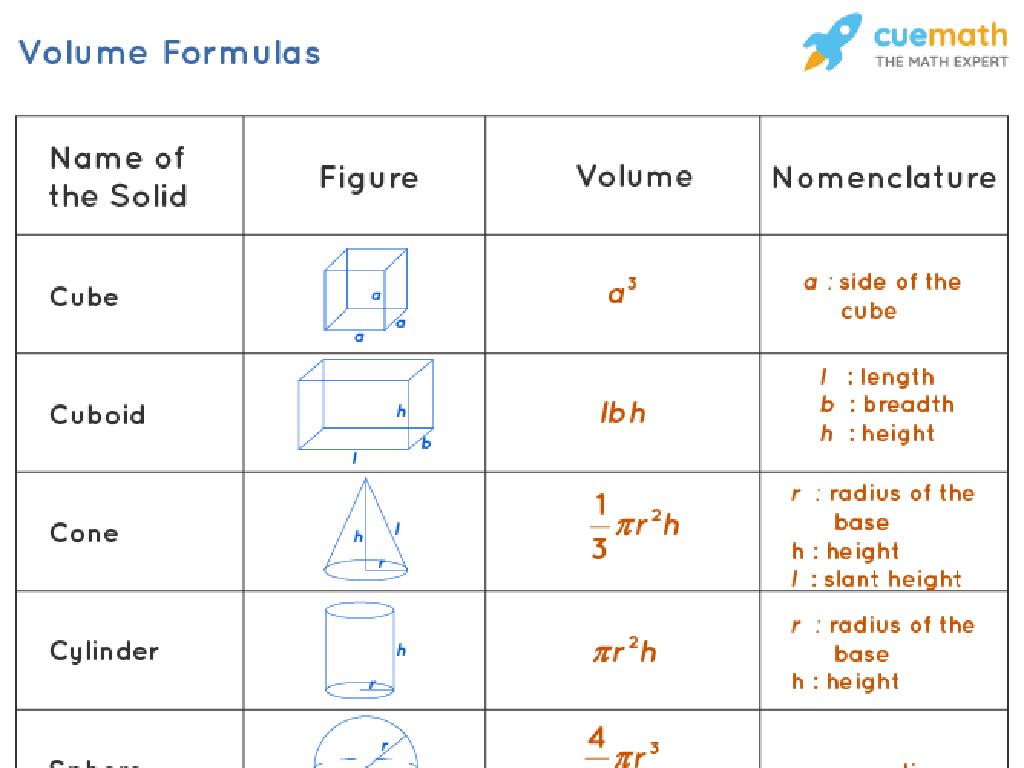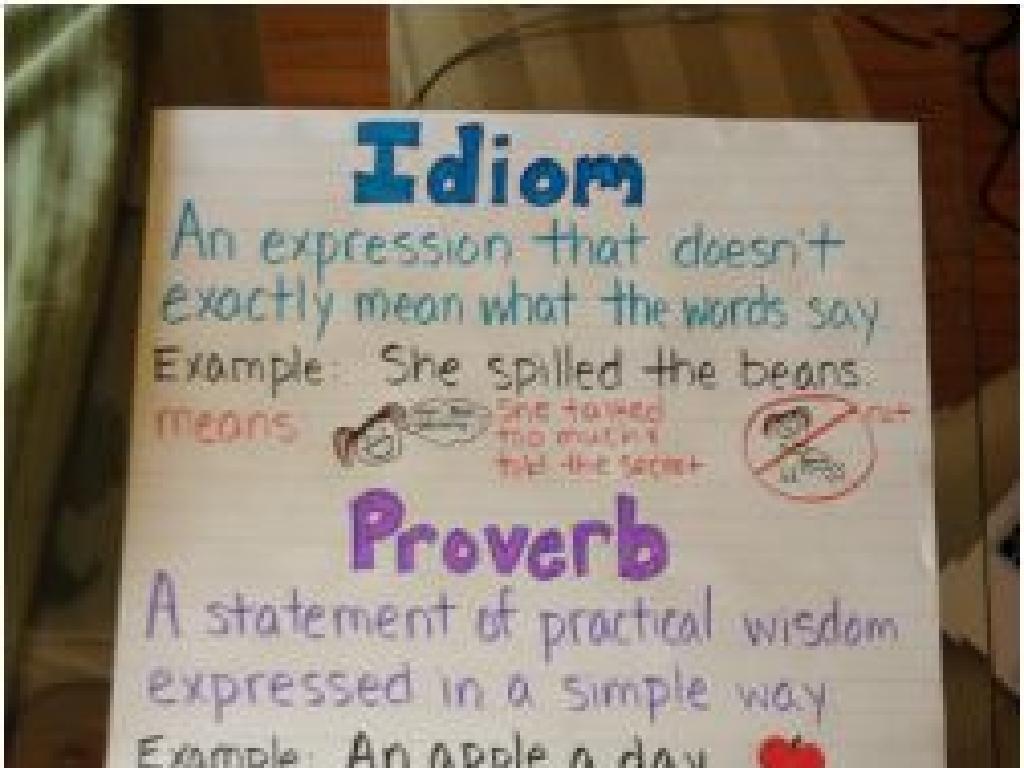Write An Equation From Words
Subject: Math
Grade: Seventh grade
Topic: One-Variable Equations
Please LOG IN to download the presentation. Access is available to registered users only.
View More Content
Introduction to One-Variable Equations
– Understanding one-variable equations
– An equation with one variable represents a balance of two expressions.
– Equations as balance scales
– Each side of the equation must have equal value, like a balanced scale.
– Real-life equation applications
– Examples: budgeting allowance, calculating distance.
– Solving for the unknown
– Find the value of the variable that makes the equation true.
|
This slide introduces the concept of one-variable equations to seventh-grade students. Start by explaining that an equation is a statement that two expressions are equal, and it often contains an unknown variable that we need to solve for. Draw an analogy to a balance scale to help students visualize that both sides of the equation must be balanced, meaning they have the same value. Provide relatable examples such as budgeting their weekly allowance or calculating the distance they can travel with a given speed to show how equations are used in everyday life. Finally, guide students through the process of solving for the unknown variable, emphasizing that finding this value is like solving a mystery in math.
Translating Words to Symbols
– Key terms and math symbols
– Terms like ‘sum’ mean ‘+’, ‘difference’ mean ‘-‘
– Understanding the equals sign
– The equals sign ‘=’ shows balance between two sides
– Practice with simple phrases
– Turn ‘the sum of 5 and a number’ into ‘5 + n’
– Building one-variable equations
– Use symbols to represent words and form an equation
|
This slide is aimed at helping students grasp the concept of translating verbal phrases into mathematical expressions, which is a fundamental skill in algebra. Start by identifying common terms used in word problems and their corresponding mathematical symbols. Emphasize the importance of the equals sign as a symbol that represents balance and shows that two expressions are equal. Engage students with examples, turning simple phrases into math expressions. For instance, translating ‘the total of 5 and a number’ into ‘5 + n’. Encourage students to practice this skill by creating their own phrases and translating them into equations. This will prepare them for solving one-variable equations in future lessons.
Writing Equations from Words
– Break down word problems
– Dissect the problem into manageable parts
– Identify variables/constants
– Variables are unknowns, constants are fixed numbers
– Write equations from examples
– Example: ‘Five more than a number is twelve’ becomes x + 5 = 12
– Practice with class problems
|
This slide introduces the process of translating word problems into mathematical equations, a key skill in algebra. Start by breaking down the problem into smaller, understandable parts. Next, identify the variables (unknown quantities) and constants (known values). Use an example to illustrate the process: for instance, the phrase ‘five more than a number is twelve’ can be represented by the equation x + 5 = 12, where ‘x’ is the variable representing the unknown number. Encourage students to practice this skill by writing equations from word problems provided in class, reinforcing their understanding through repetition and variation.
Solving One-Variable Equations
– Goal of solving equations
To find the value of the variable that makes the equation true.
– Use inverse operations
Operations that reverse effects of each other, like addition and subtraction.
– Step-by-step practice problem
Example: Solve 3x + 4 = 19. Subtract 4, then divide by 3.
– Isolating the variable
|
The objective of solving one-variable equations is to determine the value of the unknown variable that satisfies the equation. To achieve this, students should use inverse operations, which are mathematical operations that undo each other, such as addition and subtraction or multiplication and division. Provide a practice problem and guide students through the steps to solve it, ensuring they understand the process of isolating the variable to find its value. For example, in the equation 3x + 4 = 19, students should first subtract 4 from both sides to get 3x = 15, and then divide both sides by 3 to find x = 5. Encourage students to work through additional problems to reinforce the concept.
Class Activity: Equation Creation
– Craft your own word problem
– Convert the problem into an equation
– Use variables to represent unknown numbers
– Exchange problems with a classmate
– Solve your partner’s equation
– Apply math skills to find the solution
|
This activity is designed to engage students in creating and solving one-variable equations from word problems. Students should use real-life scenarios to formulate their problems, encouraging them to think critically about how math applies to everyday situations. After writing their word problems, they’ll translate them into mathematical equations, using a variable to represent the unknown quantity. Once they swap with a partner, they’ll have the opportunity to interpret and solve a peer’s problem, which reinforces their understanding of the topic. For the teacher: Provide guidance on structuring word problems and forming equations. Offer examples of common words that indicate mathematical operations (e.g., ‘total’ for addition, ‘difference’ for subtraction). Prepare to assist students who may struggle with the concept of variables. Have a list of potential word problems on hand for students who may have difficulty coming up with their own.
Review and Reflect: Equations from Words
– Recap today’s key points
– Discuss common challenges
– Issues like misunderstanding the problem or incorrect variable representation
– Strategies to tackle difficulties
– Review examples, practice problems, and ask questions
– Engage in Q&A session
|
This slide aims to consolidate the learning from the lesson on converting word problems into one-variable equations. Begin by summarizing the main topics covered, such as identifying variables, setting up equations, and translating words into mathematical symbols. Address common issues students may face, like misinterpreting the language of the problem or representing variables incorrectly. Offer strategies to overcome these challenges, such as re-reading the problem, breaking it down into smaller parts, or using a problem-solving checklist. Conclude with a Q&A session, encouraging students to ask questions about any aspect of the lesson they are unsure about. This interactive session will help reinforce their understanding and address individual concerns.





